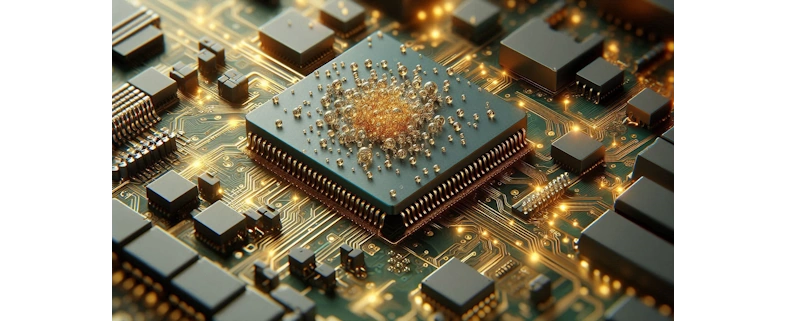
Why recycling gold
In 20 years, there will be no more gold to extract. Did you know that you handle gold every day? Yes, there is gold in your smartphones and computers! However, when our electronic devices reach the end of their useful life, we forget about them in a corner. So let’s talk about recycling gold from your electronic devices.
To understand the real usefulness of gold in the different areas of society, you must first know its different physicochemical properties. Gold is a metal that has very good electrical and thermal conductivity as well as great ductility. Gold is especially characterized by its inalterability, which is due in particular to its chemical inertness and its great stability.
This makes it a stainless metal and resistant to most acids under normal temperature and pressure conditions. However, under certain extreme conditions of temperature and/or pressure or in the presence of specific reagents, gold can change oxidation states and form complexes.
Gold comes mainly from mining and gold panning in gold-bearing rivers. It is extracted mainly using cyanide or mercury. Cyanide is mostly used on an industrial scale. As for mercury, it is used by small operations and in gold panning because its extraction process requires little infrastructure.
Gold is mainly used in jewelry because of its stainless nature. For the same reason, it is also very present in the electronics and IT sector. It is also used in dentistry and more generally in medicine in specific treatments for certain diseases such as cancer. Because of its chemical inertness, it is used to manufacture surgical and laboratory instruments.
Finally, thanks to its stability and its ability to reflect infrared radiation, it is used in satellites and on the visors of astronauts’ helmets. In chemistry, gold is mainly used as a catalyst. It is particularly essential in the preferential oxidation of carbon monoxide, which is a key step in the proper functioning of fuel cells. It is widely used in environmental chemistry because carbon monoxide is one of the main polluting gases.
Recycling gold in electronic waste
Gold is a precious metal that can be recycled many times while retaining its properties and quality. Recycling is very important to avoid rapid depletion of resources. There is also a very big ecological issue because gold mining is extremely polluting because of the cyanide and mercury used for extraction. In addition, in illegal gold mining, the mercury used poisons the earth and surrounding waters.
The development of recycling techniques has made it much less polluting than extraction. From an economic point of view, recycling gold is much more interesting than extracting it. According to a recent study, recycling would be 24 times less expensive than extracting it.
Waste containing gold multiplies over time. In addition, it contains a large quantity of the metal. In 1 ton of electronic waste, an average of 300 to 400g of gold is recovered. Gold comes mainly from gold mining (74%), then it comes from the recycling of jewelry, ingots and coins (23%) and finally from the recycling of electronic waste (3%). However, electronic waste is present in enormous quantities. A big advantage of recycling this waste is that it contains many other metals than gold and often in larger quantities.
Electronic waste, after being divided according to its composition, is crushed to allow the separation of plastic and metal parts.
The separation can be refined by magnets, by electrostatic method which separates the components by electrical conductivity, by very fine grinding which allows the light plastic particles to remain on the surface, or by organic solvents which dissolve the resin binding the metallic parts to the non-metallic ones. Then, there are several techniques to separate the gold from the rest of the remaining metallic fraction.
Pyrometallurgical consists of heating these metals to a high temperature so that they melt. Several layers are formed during the melting, which allows the different constituents to be separated. This technique is abundant in industry, economically interesting but very energy-intensive and has a low selectivity compared to individual metals.
Hydrometallurgy uses chemical separation techniques. Gold is present in elemental form on printed circuits and must therefore be oxidized during separation. This can be achieved by different oxidizing agents such as cyanide, thiocyanate, thiourea or thiosulfate. Aqua regia, a mixture of HCl and HNO3, can dissolve gold in the form of HAuCl4.
A new method for recycling gold
Recycling gold from computer or smartphone circuit boards is possible. Researchers at the Swiss Federal Institute of Technology Zurich (ETH) have developed a method for this purpose. It uses a sponge made of protein fibers, made from whey.
Used computers and smartphones contain copper, cobalt and a small amount of gold. However, the processes used to date for recycling gold consume a lot of energy and require highly toxic chemicals.
However, researchers at ETH have just developed a method that is as effective as it is inexpensive and, above all, much more in line with sustainable development. They have developed a sponge made of an interweaving of protein fibers, made from whey.
To do this, they denatured whey protein. They used high heat and acid to form protein nanofibers in a gel. They then dried the gel to form a sponge. To extract gold from scrap metal, the researchers dissolved the metal parts in acid so that the gold appeared as ions. They then immersed the sponge in the solution of metal ions. As a result, the gold ions were deposited very effectively on the sponge fibers.
In tests conducted on 20 used computer boards, the Zurich researchers managed to recycle 450 milligrams of 22-carat gold nuggets. They now intend to commercialize their technique.
